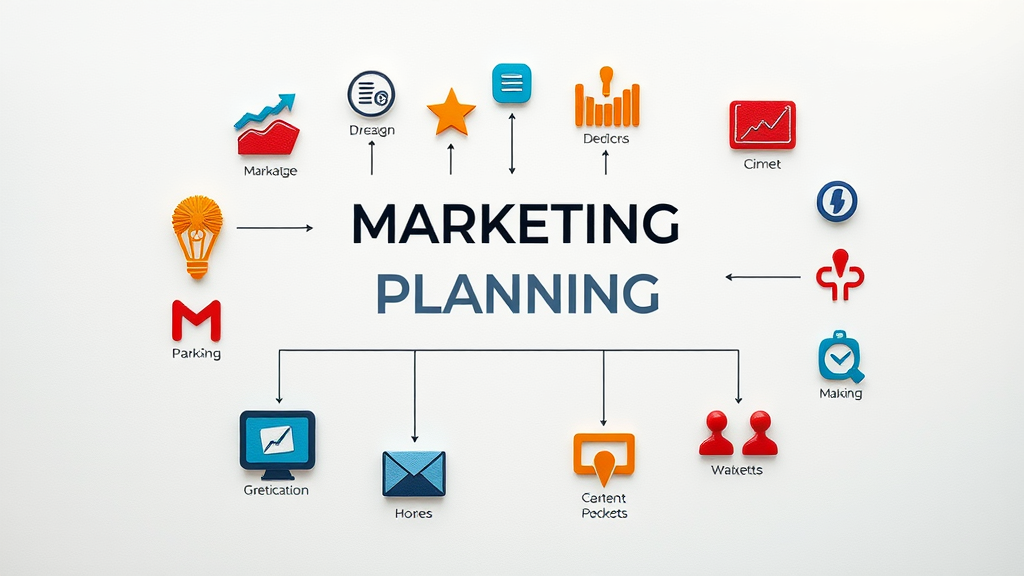Did you know that only 37% of businesses have a documented strategic marketing plan? This startling statistic highlights a hidden gap that separates market leaders from followers. Yet, strategic marketing planning is the proven key to unlocking unprecedented growth, driving alignment between your marketing strategy and business goals, and outpacing the competition. Whether you’re aiming for scalable expansion or lasting relevance in today’s crowded marketplace, this guide will reveal the secrets behind why some businesses soar while others stall—starting with the very foundation of how they plan their marketing success.
Revealing the Power of Strategic Marketing Planning: Surprising Facts That Drive Growth
The influence of strategic marketing planning can be surprising—especially when most business owners believe generic marketing efforts are enough. In reality, companies with a documented marketing plan are twice as likely to reach their targets than those without one. Using strategic marketing techniques means setting clear business goals, aligning resources, and proactively anticipating market changes. Practical examples include how leading brands tailor their marketing strategies to seasonal trends, leverage deep market research, and execute cross-channel campaigns that resonate with a well-defined target audience . Each of these elements represents a concrete step in the planning process , making the difference between blind promotion and sustainable market leadership.
What makes the power even more compelling is the ripple effect on every facet of a business. A company with a robust strategic marketing plan aligns staff across departments, optimizes its budget, and thrives in competitive environments by leveraging data for laser-focused campaigns. From small business startups to large enterprises, understanding—and applying—the principles behind strategic marketing planning is the first step toward explosive growth and enduring success.
Shocking Insight: Only 37% of Organizations Have a Documented Strategic Marketing Plan
Despite its proven benefits, research reveals that just 37% of organizations have a documented strategic marketing plan . This oversight leaves many businesses operating reactively—chasing daily sales targets without a long-term strategy. In contrast, those who intentionally document and execute their marketing planning process enjoy higher accountability, clearer measurement of results, and stronger alignment between their strategic plan and market development efforts. As a result, they stand out as leaders in their industries, better equipped to adapt and thrive in changing environments.

Strategic marketing planning is most effective when it’s supported by a skilled team that understands both the big picture and the tactical details. If you’re interested in how expert collaboration can elevate your marketing initiatives, explore the importance of assembling the right marketing team to drive your strategy forward.
How Strategic Marketing Planning Aligns with Business Goals
Every successful business journey starts by aligning strategic marketing planning with clear and measurable business goals . When business leaders set objectives—such as increasing market share, launching a new product, or improving brand awareness—a well-crafted marketing plan becomes the roadmap to achievement. By integrating marketing strategies into the broader strategic plan , companies ensure that every marketing effort supports long-term organizational growth. Practical examples abound: A technology startup, for instance, may use social media campaigns aligned with its goal to become a thought leader in innovation, while a retail brand could focus on content-driven strategies that foster customer loyalty.
This alignment provides structure and clarity, allowing all teams to move in the same direction. Key performance indicators (KPIs) are established at this stage, ensuring progress can be measured continuously. When the marketing planning dovetails with company priorities, it motivates employees, reduces wasted resources, and creates a strong competitive advantage—evident in companies that consistently meet or exceed their targets through aligned, focused efforts.
Strategic Marketing Planning and the Importance of Clear Business Goals
Setting clear business goals at the start of the strategic marketing planning process is vital for direction and cohesion. Without well-defined objectives, marketing activities risk becoming disjointed or misaligned, making it challenging to assess success or pivot when necessary. For instance, an organization aiming to expand internationally requires its marketing strategy to support this ambition, perhaps by launching region-specific marketing campaigns or adapting content for new markets. Such clarity enables teams to prioritize initiatives that directly contribute to the organization’s mission and vision.
Furthermore, measurable marketing goals such as increasing qualified leads by 25% in the next quarter or boosting customer retention rates by 10% ground the marketing effort in tangible outcomes. These benchmarks are tracked through regular reviews, ensuring every marketing program remains on course. Ultimately, crafting a strategic marketing plan with clear business and marketing goals creates the discipline required for sustained organizational progress.
List: Ways Strategic Marketing Planning Drives Business Success
- Aligns marketing efforts with organizational vision and mission
- Maximizes ROI by targeting the right audience with the right message
- Enables more accurate budgeting and resource allocation
- Enhances agility by proactively adapting to market changes
- Fosters cross-departmental collaboration for holistic growth
What You’ll Gain from Mastering Strategic Marketing Planning
- Understand the strategic marketing planning process from start to finish
- Learn to define, execute, and measure marketing goals
- Discover proven marketing strategies to enhance competitive advantage
- Identify and engage with your ideal target audience
- Master the integration of market research and market development into your strategic marketing plan
- Apply best practices in marketing planning to achieve sustainable growth

A Comprehensive Overview of Strategic Marketing Planning
To truly unlock growth, businesses must move beyond generic marketing approaches and embrace strategic marketing planning as an ongoing discipline. This comprehensive approach weaves together research, analysis, action, and measurement across all marketing channels . Understanding what sets strategic marketing planning apart helps organizations create agile, goal-driven marketing efforts that leverage both digital and traditional channels for optimal impact.
From defining precise marketing objectives to developing market development initiatives and leveraging robust analytics, a holistic strategic marketing plan offers a clear framework for turning company vision into market reality. Let’s explore essential differences and practical definitions to guide your next steps.
Defining Strategic Marketing Planning in Today’s Business Landscape
Strategic marketing planning refers to a structured process of analyzing the competitive environment, identifying opportunities, and designing a targeted approach to achieve specific business goals. Unlike ad-hoc or reactive planning, this method brings order, vision, and purpose to every marketing effort . In the fast-changing digital landscape, integrating market research , customer insights, and data-driven strategies is now essential for building effective marketing campaigns.
With the proliferation of social media and rapid shifts in consumer behavior, today’s strategic marketing plan goes beyond one-size-fits-all solutions. It requires businesses to craft unique value propositions, optimize resource allocation, and anticipate customer needs before they arise—thereby solidifying a strong competitive foothold.
Contrast: Marketing Planning vs. Strategic Marketing Planning
While both concepts serve critical roles in advancing business objectives, there are marked differences between basic marketing planning and strategic marketing planning . A traditional marketing plan often focuses on short-term campaigns, limited product launches, or incremental improvements. It might outline tactics for advertising or promotions with minimal connection to long-term company vision. In contrast, a strategic marketing plan is rooted in the broader strategic plan , aligning with overarching business goals, and considering the competitive landscape, resource constraints, and evolving market demands.
This distinction is crucial for growth-minded organizations. Strategic marketing planning incorporates ongoing analysis and iterative refinement, making it a dynamic, evolving framework. By contrast, standard marketing plans may lack adaptability or miss out on valuable market development opportunities. For sustained success, championing a strategic approach is the new standard for business excellence.
| Aspect | Strategic Marketing Planning | General Marketing Planning |
|---|---|---|
| Key Differences | Long-term, aligns with overall business strategy, competitive analysis, proactive adaptation | Short-term, campaign-focused, limited analysis, tends to be reactive |
| Implementation Steps | In-depth research, goal-setting, strategy selection, execution, ongoing evaluation | Basic goal identification, tactic selection, execution, basic tracking |
| Focus | Market leadership, sustainable growth, cross-functional alignment | Immediate sales objectives, promotional activities |
| Outcomes | Long-term growth and adaptability in changing markets | Short-term gains, risk of stagnation |

Step-by-Step Guide: The Strategic Marketing Planning Process
The strategic marketing planning process is a systematic journey that ensures marketing success by connecting high-level business goals to everyday execution. This guide will walk you through each critical phase so your team can move confidently from vision to measurable results. Mastering this process ensures you set the foundation for your next winning marketing strategy .
Whether you’re an entrepreneur tackling your first big launch or a corporate executive refining existing marketing efforts , the following steps will keep your marketing plan effective and agile in today’s complex market environments.
Video: Introduction to the Strategic Marketing Planning Process
Want a visual breakdown of the full strategic marketing planning process ? Watch this short explainer video for an overview of the essential phases—then come back for the deep dive below to implement each step in your organization.
Phase 1: Setting Business Goals and Marketing Goals
The first phase is the foundation of successful marketing planning : Setting clear business goals and marketing goals . Think of business goals as the “destination”—for example, expanding into new markets or increasing market share by 20% in the next two years. Marketing goals are the “routes” you use, such as driving 1,000 new leads per quarter or boosting brand engagement by 30% through improved content and social media strategy.
It’s vital that both business and marketing goals are measurable, achievable, relevant, and time-bound. Setting these targets from the outset allows for precise tracking and seamless adaptation as the market evolves, giving your strategic marketing plan the disciplined structure needed for real results.
Phase 2: Conducting Effective Market Research in Strategic Marketing Planning
Market research underpins truly effective strategic marketing planning . Begin with quantitative research—collecting industry data, sales trends, and competitor performance analytics. Follow up with qualitative efforts such as customer interviews, focus groups, and online sentiment analysis. This dual approach uncovers both big-picture opportunities and detailed pain points, fueling a marketing plan built on customer-centric solutions.
With data in hand, assess your current position in the strategic market. What threats and opportunities exist? Are there gaps in your product or service offerings when compared to competitors? Answering these questions ensures your chosen marketing strategies are relevant, timely, and impactful.

Phase 3: Defining Your Target Audience in Your Strategic Marketing Plan
Next, clarify exactly who your target audience is. Segmentation here is essential: Use demographic data (age, location, job title), psychographic profiling (interests, values), and behavioral signals (purchasing history, online engagement) to define who will benefit most from your product or service. Personas are invaluable tools at this stage, ensuring your messaging resonates and that resources are allocated efficiently.
Getting your target audience right magnifies the impact of every marketing effort, allowing you to tailor campaigns across channels for maximum engagement and conversion.
Phase 4: Deciding on Marketing Strategies and Channels
With goals and audiences defined, choose the best marketing strategies and channels to reach them. In today’s mix of digital and traditional options, this might mean a blend of social media content, email campaigns, influencer partnerships, event sponsorships, and even direct mail where appropriate. The key is to map out which strategies align best with your goals, audience preferences, and budget.
Testing and learning are vital. Track which marketing channels deliver the highest return—adjusting in real time to optimize performance within your strategic marketing plan .
Phase 5: Planning and Executing Strategic Market Development
Market development refers to expanding your reach—whether entering new regions, launching new products, or pursuing untapped customer segments. Success hinges on careful analysis, creative positioning, and multi-channel execution. Develop a strategic roadmap that outlines key milestones, from product adaptation to channel partner selection and promotional tactics.
This stage of the planning process emphasizes growth through strategic initiatives that fuel both near-term wins and long-term business expansion.

Phase 6: Measuring and Adjusting Your Strategic Marketing Plan
No marketing plan is static—measuring results against KPIs is the linchpin of ongoing success. Analyze metrics such as lead generation rates, cost per acquisition, customer lifetime value, and market share growth. Utilize dashboards and analytics software for real-time tracking, so teams can respond quickly to underperforming tactics or capitalize on new opportunities.
Regular adjustment based on these analytics transforms your strategic marketing plan into a living document—ensuring your organization stays ahead of competitors and moves steadily toward its business goals.
Marketing Plan vs. Strategic Plan: Aligning Marketing with Broader Business Objectives
It’s easy to confuse a marketing plan with your broader strategic plan , but both serve distinct purposes. The strategic plan articulates the company’s overall vision—its mission, core values, and primary business goals—while the marketing plan details how to reach target customers, communicate value, and convert interest into sales. For maximum effectiveness, these two plans should work in concert, reinforcing each other and creating a unified focus across all levels of the business.
When marketing planning seamlessly integrates with corporate strategy, it helps teams avoid siloed thinking and ensures that every marketing activity directly supports larger organizational priorities.
How a Strategic Marketing Plan Integrates with a Company’s Strategic Plan
A truly effective strategic marketing plan is designed after careful review of the company’s overarching strategic plan . It translates business objectives—such as expansion or brand repositioning—into specific marketing goals and campaigns. For example, if sustainable growth is a strategic objective, the marketing strategy might emphasize brand storytelling, sustainability-focused content, and eco-friendly product innovation.
This integration is not a one-time event, but an evolving relationship that adapts as marketplace conditions shift. Cross-functional leadership meetings, shared KPIs, and unified project timelines are just a few best practices used by top-performing organizations to ensure absolute alignment between their strategic marketing plan and overall company vision.
“A successful strategy requires not only insight but also agility—today’s most adaptive businesses thrive with forward-thinking marketing plans.”
Developing Marketing Goals and Objectives in Strategic Market Environments
Setting strong marketing goals and objectives is how organizations turn high-level vision into actionable success. The process begins with a grounded understanding of your strategic market: What are its size, trends, and pain points? Which objectives will make the most impact given your resources and market position? By being analytical and targeted, you position your brand for meaningful, measurable progress.
Defining Measurable Marketing Goals Within Your Strategic Market
All credible marketing goals should be quantifiable and deadline-driven. Popular frameworks like SMART goals—Specific, Measurable, Achievable, Relevant, and Time-bound—enable teams to stay focused and accountable. Examples include: “Increase qualified website leads by 30% over the next two quarters” or “Achieve a customer satisfaction rating above 90% after this year’s major product launch.”
Selecting key performance indicators (KPIs) tailored to your market ensures efforts are tracked precisely and resources deployed most effectively. This habit of goal-driven planning is what separates strong strategic marketing plans from the rest.
SMART goals for strategic marketing; Key Performance Indicators (KPIs) you should track; Examples of effective marketing objectives
- SMART Goal Example: “Grow Instagram engagement rate from 2% to 4% in six months by publishing twice-weekly educational videos.”
- Key Performance Indicators: Lead generation metrics, conversion rates, cost per acquisition, customer lifetime value, and market share growth.
- Effective Objective Example: “Expand into two new regional markets by end of fiscal year, with at least a 10% local market share at launch.”

Market Research: Foundation of Every Strategic Marketing Plan
Robust market research is the backbone of every high-performing strategic marketing plan. By systematically collecting and analyzing customer, competitor, and industry data, companies identify where real opportunities—and risks—exist. Thorough market research supports not just the marketing planning process, but every strategic decision from new product launches to expansion into unfamiliar markets.
Practical tools range from online surveys and CRM analytics to competitive benchmarking and focus group interviews. The goal is to develop a data-rich, unbiased picture of the market, empowering your team to prioritize marketing strategies that deliver maximum value.
Practical Steps for Conducting Market Research
- Define research objectives based on business goals
- Select data collection methods (surveys, social listening, competitor analysis, etc.)
- Analyze findings for actionable insights and trends
- Apply results to refine strategic marketing planning and guide next steps
Leveraging Data to Inform Your Strategic Marketing Planning Process
Data isn’t just for decision-making—it powers continual improvement. Use analytics tools to monitor customer behavior, measure the effectiveness of in-progress campaigns, and identify new market development opportunities. When your strategic marketing planning process is informed by real-world evidence, each adjustment adds measurable value, helping you outcompete less data-savvy rivals.
Target Audience Analysis for More Effective Strategic Marketing Planning
No marketing effort can succeed without a clear handle on your target audience . Analyzing and segmenting your audience ensures campaigns are precise and content truly resonates. Characteristics like age, location, income, preferences, and buying habits are just the start; the best strategic marketing plans layer in psychographic and behavioral data for hyper-focused engagement.
Identifying and Segmenting Your Target Audience
Begin by reviewing existing customer data, then segment your audience according to key variables. Develop buyer personas for your primary segments—these act as guiding “avatars” for all messaging and strategy. Adjust segmentation as you gather new data, remaining agile as your strategic market evolves.

Case Study: Successful Strategic Marketing Planning Focused on Audience Needs
Consider a mid-sized SaaS company that aimed to double its market share within two years. By investing in deep audience research, it discovered a significant portion of its users found onboarding confusing. The business revised its marketing plan to include educational content, personalized email campaigns, and live webinars targeting this pain point. As a result, trial-to-paid conversion rates increased by 40%, customer satisfaction soared, and the brand achieved its ambitious growth targets—proving the power of audience-centric strategic marketing planning.
This example underscores how prioritizing audience insights at every stage of your planning process leads to more impactful, agile marketing strategies.
Choosing the Right Marketing Strategies and Channels
One size never fits all in marketing strategies . Selecting the best mix of channels—paid, earned, owned, online, and offline—requires rigorous analysis of your target audience’s habits, the strengths of each channel, and alignment with business and marketing goals. Whether it’s social media, SEO, influencer marketing, print ads, or trade shows, the key is coordination and consistent messaging across all touchpoints.
Adapting Your Strategic Marketing Plan to Digital and Traditional Channels
The modern strategic marketing plan must thrive across digital and traditional media. Your team should be equally adept at optimizing Facebook ad campaigns and designing direct mail pieces or radio scripts. Successful businesses track which channels yield the lowest customer acquisition costs and highest ROI, continuously allocating budget to the highest performers while testing new approaches for incremental gains.
Integration is the name of the game—consistency in brand messaging and seamless customer experience, regardless of the channel, ultimately determines the marketing program’s success.
Video: Top Marketing Strategies for Modern Strategic Marketing Planning
For practical inspiration and up-to-date tactics on what’s working in today’s landscape, watch our featured video covering top marketing strategies—from influencer collaborations to advanced automation tools—tailored to strategic marketing planning.
Measuring Success: KPIs and Analytics in Strategic Marketing Planning
The final pillar of effective strategic marketing planning is measuring and optimizing performance. Trackable KPIs and clear analytics allow teams to prove the value of their marketing efforts, secure ongoing investment, and continuously outpace competitors.
Lead generation metrics; Customer acquisition cost; Marketing ROI; Customer lifetime value; Market share growth
- Lead Generation Metrics: Number and quality of new leads generated monthly
- Customer Acquisition Cost (CAC): Total spent to acquire each customer
- Marketing ROI: Revenue generated per dollar spent on marketing
- Customer Lifetime Value (CLV): Estimated net profit from each customer over the relationship
- Market Share Growth: Increase in percent of total market captured
Table: Sample Metrics for Monitoring Strategic Marketing Plan Performance
| Metric | Description | Example Target |
|---|---|---|
| Lead Generation | Monthly qualified leads captured | 1,000/month |
| CAC | Cost per acquired customer | $50/customer |
| Marketing ROI | Revenue per dollar spent | 5:1 ratio |
| CLV | Total value over customer lifespan | $2,000/customer |
| Market Share | Percent of target market owned | +5% annual growth |
Optimizing and Adapting Your Strategic Marketing Planning for Long-Term Growth
Agility is non-negotiable in strategic marketing planning . Market trends shift rapidly and competitors never stand still. Cultivating a culture of continuous improvement using data insights and team feedback ensures your marketing plan remains effective year after year.
Set frequent reporting schedules, embrace experimentation, and empower teams to pivot quickly when goals, markets, or technologies evolve.
The Role of Agility and Continuous Improvement in Strategic Marketing
In practical terms, agility means reviewing marketing KPIs monthly, running A/B tests on major campaigns, and encouraging open feedback across marketing and sales teams. Rapid learning cycles help refine your strategic marketing plan in real-time—maximizing budget efficiency and seizing opportunities before competitors react.
Agility and continuous improvement are the hallmarks of organizations that not only survive but lead in highly competitive environments.
“Strategic marketing planning is not a one-time event, but an ongoing journey to market leadership.”
Let this mindset drive your business—and you’ll remain ahead of the curve, resilient in the face of any challenge.

People Also Ask: What is the strategic planning of marketing?
Strategic planning of marketing involves defining company mission, setting measurable marketing goals, analyzing the market, allocating resources, and executing strategies that align with long-term business goals.
People Also Ask: What are the 5 steps in strategic planning?
The five key steps are: 1) Define vision/mission, 2) Analyze environment, 3) Develop strategies, 4) Implement actions, 5) Evaluate and adjust.
People Also Ask: What are the 7 strategic marketing planning processes?
The seven processes are: 1) Situation analysis, 2) Market research, 3) Target audience selection, 4) Setting objectives, 5) Develop marketing strategies, 6) Plan execution, 7) Monitoring/adjustment.
People Also Ask: What are the 5 steps of the strategic marketing process?
The five steps are: 1) Identify mission/vision, 2) Set objectives, 3) Design marketing strategies, 4) Implement programs, 5) Monitor results.
Video: Real-World Examples of Strategic Marketing Planning in Action
Check out our video spotlighting companies that grew rapidly by applying strategic marketing planning best practices—featuring stories of digital-first campaigns, adaptive repositioning, and data-driven market expansion.
Strategic Marketing Planning FAQs
- How often should you update your strategic marketing plan? Best practice is to review and adjust your strategic marketing plan at least quarterly, with an in-depth overhaul annually or whenever there’s a major shift in the business environment.
- Which metrics are most important for strategic marketing planning? Key metrics include lead generation, customer acquisition cost, marketing ROI, customer lifetime value, and market share growth.
- Can small businesses benefit from strategic marketing planning? Absolutely. Strategic marketing planning can help small businesses clarify focus, allocate limited resources efficiently, and position themselves advantageously against larger competitors.
Summary of Key Takeaways in Strategic Marketing Planning
- Strategic marketing planning is essential for sustained growth
- Aligning marketing planning with overall strategy yields better results
- Continuous improvement and agility are key in today’s markets
If you’re ready to take your marketing strategy to the next level, consider how a holistic approach can transform your entire business trajectory. Beyond planning and execution, understanding the broader landscape of digital transformation and innovation is crucial for staying ahead. For a deeper dive into how advanced digital solutions and strategic thinking can accelerate your growth, visit the AI Web Force home page and discover resources designed to empower your marketing evolution. Unlock new possibilities and position your brand for long-term leadership in a rapidly changing marketplace.
Unlock Next-Level Growth: Get Expert Guidance on Strategic Marketing Planning Now
Take your business further—reach out to our team of strategic marketing experts today. We’ll help you craft a plan that unlocks new markets, maximizes ROI, and propels your brand ahead of the competition. Start building your market leadership journey now.
To deepen your understanding of strategic marketing planning, consider exploring the following resources:
- “7 Steps To a Strategic Marketing Plan” ( indeed.com )
This article outlines a comprehensive seven-step process for developing a strategic marketing plan, including conducting market research, defining target audiences, and setting measurable goals.
- “Strategic Marketing Planning Process: Steps for Business Growth” ( graygroupintl.com )
This resource provides a detailed breakdown of the strategic marketing planning process, emphasizing the importance of setting SMART goals and aligning marketing objectives with overall business goals.
These resources offer practical insights and step-by-step guidance to help you craft an effective strategic marketing plan that aligns with your business objectives and drives growth.

